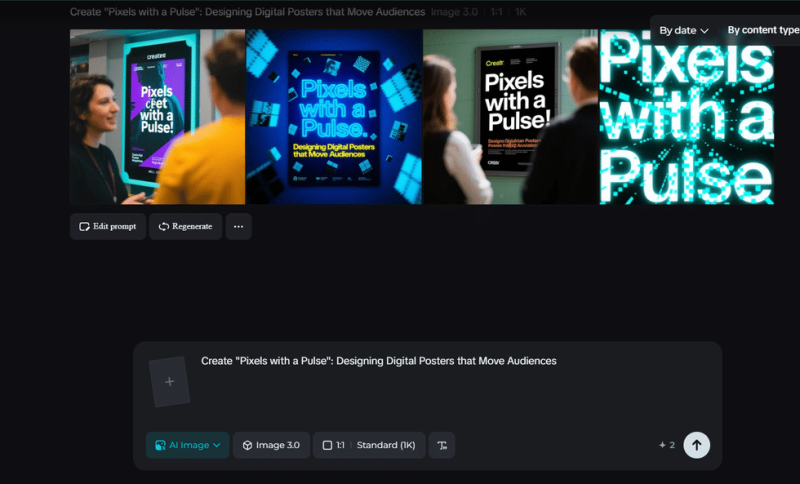It’s no longer just about static design. In a digital world of scrolling, swiping, and endless loops, motion has become emotion. A flicker of gradient, a slow expansion of color, or the pulse of light could make the flat poster something felt rather than merely seen. That’s the art of designing visuals with a heartbeat, graphics that seem to breathe rather than exist on the screen.
The digital poster is less a printed sheet today than a short performance. It responds to rhythm, timing, and subtlety. A slight shimmer may evoke excitement, a drifting shadow whispering calm. Using tools such as Dreamina, with its intelligent AI image generator, artists and marketers can now merge color psychology, geometry, and animation cues to make visuals almost alive without having to study motion design. Welcome to this kinetic world, where pixels pulse, gradients flow like music, and design behaves with its own invisible cadence.
When stillness rubs up against movement
The best digital posters exist in this in-between: not perfectly static, but not chaotic either. They breathe unthreateningly, controlling the viewer’s attention instead of assaulting it.
Try to think of it this way:
-
A gradient fade is a visual sigh, exhaling emotion from one color to another.
-
A glowing line or circle serves as the rhythm section of our engagement, setting tempo with geometry.
-
Subtle layering and parallax depth give us something more visceral, a palpable sense of space that suggests touching and distance.
These quiet gestures create a new design language that speaks to sight and instinct.
Motion becomes punctuation. Light becomes tone. And every color transition carries emotional syntax.
Cinematic emotion and the role of rhythm
There’s an inherently cinematic quality to how digital posters communicate today. While a corporate ad could shimmer in gentle waves of colour to convey elegance or tranquility, a concert poster might softly throb like bass vibrations. When rhythm is included in the design, this is what occurs. Every animation beat functions as an emotional cue:
-
The circular movement creates harmony, balance, and unity
-
Sharp cuts and flashes produce energy and urgency
-
Slow fades create suspense and anticipation.
That is why even without sound, motion-rich visuals can sing. They compose silence into a story.
From Design to Performance: Creative Flow by Dreamina
Like a music producer layering sounds to create emotion, designers can orchestrate feeling with layered texture, shape, and hue. That’s where Dreamina steps in — not as a static tool, but rather as a creative partner.
It was late and getting dark, but the hotel room was so small that we decided to take a walk rather than stay in it.
Step 1: Write a text description
First, go to Dreamina and describe the movement or feeling you’d like your poster to convey. The trick is being as descriptive and sensory as possible.
Instead of saying “animated music poster,” you could write: A glowing concert poster with abstract soundwaves emanating from a vinyl record; gentle, blue-pink gradients across the background; and circular light flares that suggest rhythm and depth.
This level of detail makes it possible for Dreamina to capture the textures, lighting, and forms that already make the image seem in motion-even without any animation.
Step 2: Tweak parameters and generate
Next, polish the visual stage: select your model, set the aspect ratio, and choose between 1K and 2K resolution according to your needs. Want a vertical format for Instagram Reels or a widescreen display for event projections? Set it here. Click the glowing icon of Dreamina to generate your visual, and seconds later, your motion-inspired concept will turn into a layered digital artwork ready for refinement.
Step 3: Customize and Download
Once generated, refine the details that make your design pop. Employ Dreamina’s AI customization tools: inpaint to add missing highlights, expand to provide elbow room, remove to eliminate distractions, or retouch to perfect textures. When you’re happy with your design, tap the Download icon to save your completed poster, all set to inspire hearts, screens, and minds.
Turning visuals into a virtual rhythm with video content
Where static posters can shimmer with simulated motion, some stories deserve literal movement. That’s where the AI video generator becomes a bridge between graphic design and animation. Just think of taking your Dreamina-generated poster and turning it into a living, breathing motion loop where gradients ripple like soundwaves and typography floats in and out like dialogue.
Designers are now using this hybrid approach to create “motion posters” that live beautifully on digital signage, social ads, or even as looping background art at events. What once required hours of animation can now be built intuitively by describing rhythm and flow instead of manually key-framing them. The result: posters that don’t stay still because neither does their audience.
Emotion in lines and light with the AI art generator
Every poster begins as a composition — a balance between geometry and feeling. Circles comfort. Angles provoke. Symmetry soothes. Dreamina’s AI art generator makes it simpler to investigate these emotive geometries: You can experiment with perspective, curvature, and spacing to gently affect how viewers react.
By merging human intuition with AI precision, designers can now test how emotional geometry behaves in real time. It’s not about replacing creativity; it’s about faster understanding of how visuals feel.
The visual heartbeat of modern marketing
Brands no longer want to be announced; they want to resonate through visuals. The most successful digital campaigns behave like living organisms these days: adaptive, emotional, subtly reactive. The next evolution in design isn’t more noise or more color; it’s more feeling.
Dreamina enables such evolution by putting the invisible at the fingertips of creativity: tone, rhythm, texture, and motion via accessible AI. Whether you’re creating a campaign teaser, an event flyer, or even a looping digital mural, you can give it pulse and breath now.
Conclusion: where stillness learns to move
Every pixel carries potential energy, a quiet readiness to transform into emotion. It is when color gradients shift, geometry aligns, and light flickers just right that design comes alive. Dreamina makes this transformation easy. While its customisation tools encourage motion, rhythm, and personality, its AI picture creator establishes the framework.
Your digital posters become dynamic instead of static when you add a little story. The next time you are designing, instead of viewing pixels as static dots, think of them as dancers who are just waiting for you to get them moving. Dreamina lets you add a pulse to every poster you create and offers you control over the stage.













